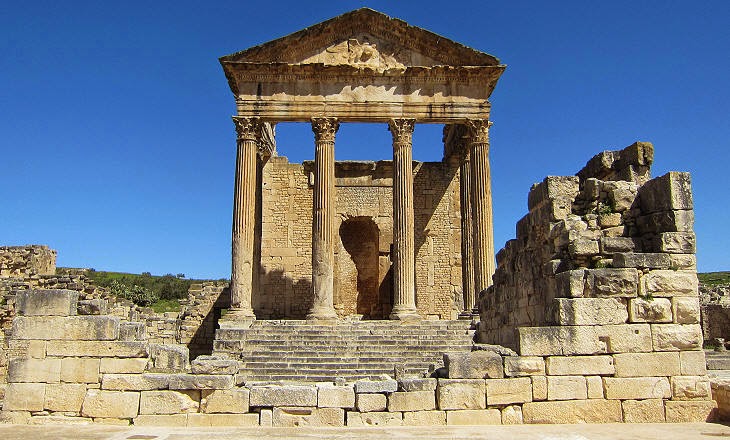 |
| The Capitolium in Thugga, Tunisia |
The Capitolium in Constantinople might have looked much like the one in Thugga, Tunisia.
.
Above is the Thugga Capitolium as seen from a breach in the Byzantine walls. The Capitolium was a temple dedicated to Jupiter, Juno and Minerva, the three gods who were worshipped in a great temple on the Capitolium Hill in Rome.
.
It was built at the center of the Forum to celebrate the concession of Roman citizenship to the inhabitants of the town by Emperors Marcus Aurelius and Lucius Verus, so it was more of a civil building than a place of worship. The ceremonies which took place in this temple were linked to lay festivities, such as the foundation of Rome on April 21st and public announcements were made from its steps.
Thugga was included in the province of Africa. Land in the Mejerda River valley was distributed to veterans and in 30 BC Legio III Augusta was permanently stationed in Africa. Thugga retains few traces of the early Roman rule; its main monuments date 2nd and 3rd century AD.
In Constantinople
The Capitol of Byzantium was without doubt built in the time of Constantine the Great and must have served originally as a pagan or semi-pagan temple connected to the imperial cult.
In the year 407, when it is first mentioned by name, the monumental cross on a column or pillar in front of it fell down during a thunderstorm and was subsequently restored. Its former use, therefore, must have already ended a long time before.
In 425, the Capitol was transformed by an imperial law into an academy of higher education, and the cookshops, which had been set up in the exedrae (apses) of the building, were closed. After this event, the Capitol is mentioned only very rarely. It was probably unused thereafter, but must have existed as a ruin through most of the Byzantine time.
 |
| The Tetrarchs in Venice. Statues of the Tetrarchs (two Augusti and two Caesares) in the act of embracing themselves were to be placed on the shafts of two adjacent columns, along with other statues. |
The Philadelphion was a public square located in Constantinople. The statue of the Tetrarchs used to decorate the entrance to the Philadelphion. The statues of the Tetrarchs were plundered during the Fourth Crusade in 1204 and brought to Venice.
A fragment of the white marble base on which the obelisk stood was discovered in the 1930’s immediately west of the Laleli mosque but it has been identified as such only recently on the basis of an inscription part of which survived on it. Interestingly, such a base would fit a porphyry obelisk fragment of which was found in the 1840’s in the Topkapi Sarayi complex and is now in the garden of the Archaeological Museum in Istanbul.
The porch at main entrance on the eastern side rested on great columns of porphyry whose exact number is unknown. Two of them, probably those in the middle, had boards on their shafts which bore the statues of the Tetrarchs. The decoration suggests that these columns were reused and had perhaps originally belonged to the palace of Emperor Diocletian (284–305) in Nikomedeia (Izmit).
The two pairs of emperors embracing each other were later regarded as the sons of Constantine the Great, and the whole building was called after them the Philadelphion, the “monument of brotherly love”.
The statues of the Tetrarchs were removed by the Venetians after the Crusader’s conquest of the city in 1204 and can still be seen on the facade of the church of Saint Mark’s in Venice. Their origin from Byzantium is proven by the fact that a broken foot of one tetrarch was found at excavations in Istanbul.
Russian pilgrims, who visited the city in the late Byzantine time, mention also two figures sitting on thrones, made of porphyry as well, probably belonging to Constantine and his father Constantius Chlorus, which broke when the westerners tried to remove them, and were therefore left behind.
 |
| A computer re-creation of the Capitolium in Constantinople. . This image used under FAIR USE from Byzantium1200. . Review for comment, criticism and scholarship as allowed under FAIR USE section 107 of the US Copyright Law. In accordance with Title 17 U.S.C. . Those who have not done so should visit the article and images published by the website Byzantium 1200 and view their article on the Capitolium of Constantinople. The artists have done a respectable if not great job. There is very little information for historians to go on. But still not too much went into the computer recreations. . Something is better than nothing. So thanks to Byzantium 1200 for giving it a try. |
(Romeartlover-Thugga) (Philadelphion) (Byzantium 1200)
1 comment:
Nice buildings . Fine words .
Post a Comment